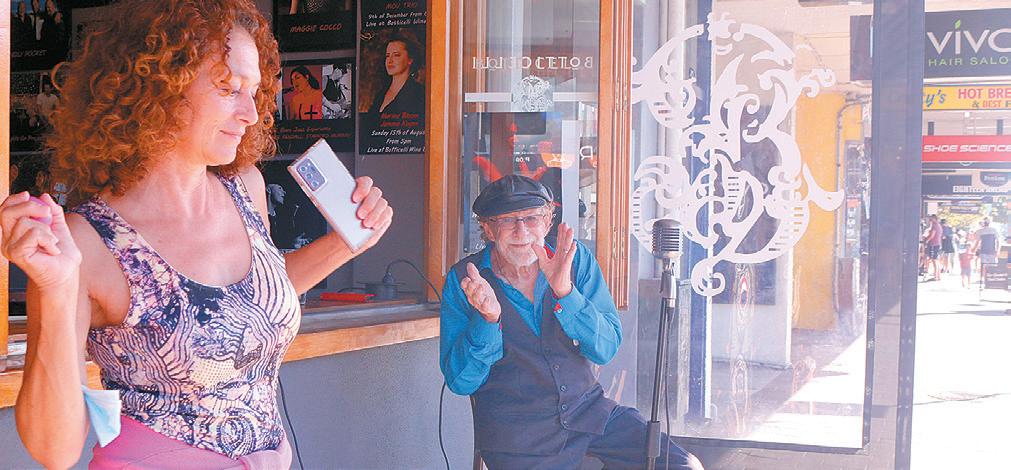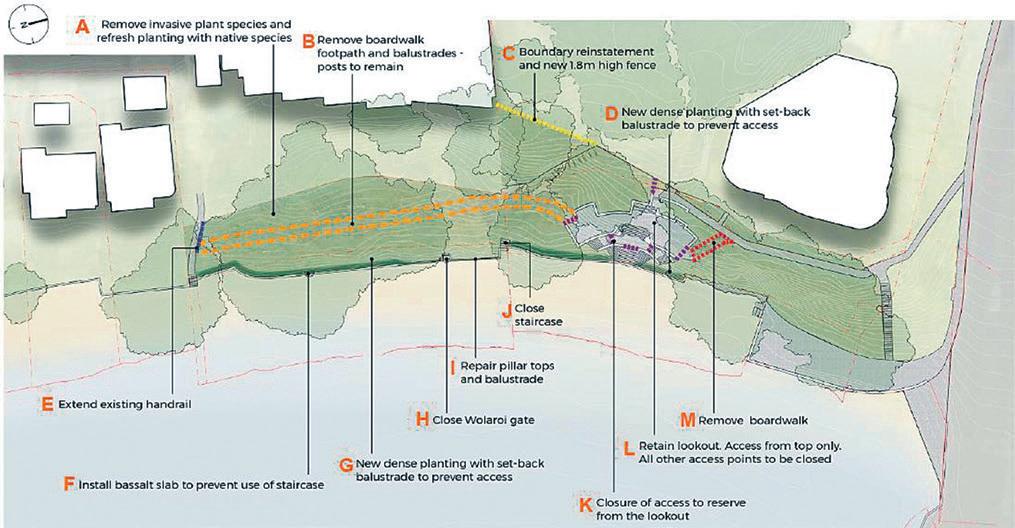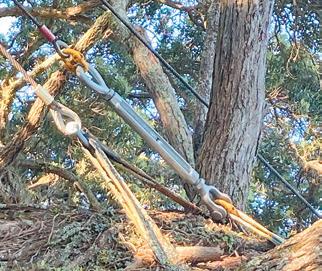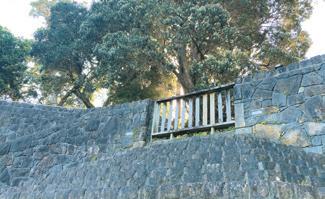
32 minute read
Veteran muso brightens a lazy Sunday
After 50 years in the music business, Paul TT (pictured above) is happy to be back sharing his sounds.
The 73-year-old played a lively selection of standards outside Takapuna restaurant Botticelli in the balmy late-afternoon last Sunday, with passers by stopping to listen.
“It’s good to get out again,” said Chris Beach, who with Maree Butler had come up from Devonport for a look after hearing about the session. They have previously enjoyed the “great venue and its great music” and are keen to return when they are able to sit inside.
Botticelli owner Diliana Klintcharova (pictured, dancing) has been doing her best to lift spirits in the meantime by inviting musicians to set up on the footpath for twice-weekly Covid-era “gigs”.
The previous weekend, a group sat over the road to listen and eat pizzas they had ordered from the restaurant, knowing a slice of the price was helping support a musician.
For Klintcharova it’s her way of helping keep music alive, even though restaurants are also doing it tough. In normal times Botticelli has live music three times a week, ranging from jazz on a Wednesday, to Brazilian tunes late on Friday and mellow popular music on a Sunday.
“That’s what I miss,” she said.
The restaurant is “surviving” by selling takeaways, but she can’t wait to reopen and will have some new skills to promote this. “I’ve learned how to use social media,” she said, while filming Paul TT’s performance.
During a break, the One Tree Hill singer and fiddle player told the Observer he is a newcomer to her fold. “She’s got a wonderful lot of musicians who play here.”
Klintcharova – who originally hails from Bulgaria and has been at Botticelli since 1994 – heard him in Birkenhead a while back and sounded him out about a solo act.
“It’s so important to be out and to share music again, he says. It makes me feel good and it makes people feel good, and it brings a touch of normality.” Donations from the public are a welcome bonus.
Earlier in his musical career, Paul played at clubs in the city, including holding a lengthy six-nights-a-week residency under The Civic in the 1960s, with popular covers band Rock Candy. A stint at the Intercontinental Hotel followed, where he met a lot of big names, including Neil Diamond, Roger Miller, David Cassidy, Lionel Richie and Santana. He’s busked in Los Angeles and Las Vegas, popped up on telethons and recorded a couple of albums. In recent years he has become a familiar face at Auckland markets. He was a regular for a decade and half at La Cigalle in Parnell.
His double-vaccinated status looks like a boon in the months ahead as the live music scene negotiates a new era.


Hear for the Holidays, North Shore

Get ready for the holidays and explore the benefits of good hearing with no risk! Enjoy a noobligation two-week trial with the latest, state-ofthe-art hearing devices. Limited availability - call today to book.

Call 09 475 9849
love your hearing
Free Trial!
Free 2-week trial with latest devices
Forgotten, frustrated and fearful – those are just a few of the words business owners hit hardest by the lingering lockdown use to describe how they feel.
Leading Takapuna hospitality owners and a popular hairdresser expressed their anger and angst at a recent forum at Smales Farm.
“It’s absurd. No one knows what is going on,” said Jennifer Morgan, of the Morgan & Morgan salon. “It didn’t need to be this hard.”
Steve Schute who owns the Elephant Wrestler on Hurstmere Rd and Regatta and Francs bar on The Strand said the industry was all about compliance, but it was not being trusted. “We’d be safer than the supermarket – they’re open.”
His losses were running at $50,000 plus a week, but he could not take forward bookings for functions because he had no idea when these could be held again. With 95 staff across three venues he worried about how to get them back and keep them motivated.
A city bar owner at the meeting, Sam Ansley of Everybodys and Roxy, said hospitality was being treated as pandemic “collateral damage”. Morgan described the description, which she had heard before, as “soul destroying”.
Service industries were not valued and were written off as low-wage employers, said another attendee.
Ansley said rule changes and drip-fed information were adding to the pain, reflecting Wellington’s lack of understanding about the cultural value of hospitality and the depth of damage it had sustained in Auckland.
Another city venue owner said a paintby-numbers approach to support meant that businesses down 40 per cent in turnover qualified for the same subsidy as those down 100 per cent.
“Everyone feels pretty neglected. We just
All ears... Simon Watts and Erica Stanford, National Party MPs for North Shore and East Coast Bays, listen to business concerns
feel like the forgotten industry,” said another.
The gathering took place outdoors at Smales Farm, with convenor and North Shore National Party MP Simon Watts saying it was designed to be small and “picnic-style” so as not to breach regulations.
The owner of The Grange, Mark Wilson, served up nibbles on his venue’s deck, in lieu of having it open to the customers he is desperate to welcome back next month.
Hearing the Prime Minister dismiss a quick change to allow more al fresco dining as “not viable” had hacked him off, he said. “Having no income for 13 weeks is not viable.”
Two key themes emerged from the nearly 20 people attending: the need for government support to carry through the first quarter next year and worries about policing vaccine mandates.
Several people spoke of concerns about anti-vaxxers disrupting trading or challenging staff. One owner said he had already been threatened online. “People are going to guerrilla warfare our venues,” said Schute. Watts said he would return to Wellington to continue to push the government on its Covid-19 pandemic management and delivery. National’s Covid-19 spokesman, Chris Bishop, also attended, as part of a day in Auckland visiting hospitality businesses. He slated Labour over its slow pace in rolling out vaccine passports and approving rapid testing. National supported a $100 voucher for vaccinated people to dine out, he said. East Coast Bays National MP Erica Stanford said the party was pushing for visas for foreign staff. University of Auckland emeritus professor of medicine Des Gorman told attendees restrictions should already have been loosened for fully vaccinated people.


Al fresco venue owner: down $2m ... and counting
Mark Wilson fears a pre-Christmas exodus of Aucklanders will kill off any “sugar rush” of customers from a December reopening of his Takapuna restaurant and bar.
At this time of year, he would expect his Smales Farm venue, The Grange, to be pumping.
Christmas parties make November the busiest month, closely followed by December, when people typically enjoy catch-up drinks.
But with the border set to reopen mid-month under the traffic light system he is not sure how things will pan out.
If cooped-up Aucklanders flocked to Omaha or Queenstown, then there might only be a fortnight of good cheer in the city, with no way of recouping what had already been lost.
“My best guess is we would be trading at 50 to 55 per cent of normal revenue,” he said.
“By the time we come out of lockdown in December we will have just a fraction over $2 million wiped off our revenue.”
On top of not making money since lockdown began in mid-August, with every month that has gone by Wilson has been putting $23,000 into the business just to keep it ready to reopen.
With plenty of outdoor seating, The Grange is ideally set up for Covid-era wining and dining, but the red-light cap of 100 people in a venue when he could fit more than three times that number in varied separate spaces will constrain the business bounce-back.
A frustrated Wilson said that even when the red light changes to orange it does not signal much moving forward for hospitality, because government financial support will be lost while trading restrictions remain, potentially after New Year which is when the business is at its quietest. “But there are no clear dates,” he said, emphasising the corrosive effect of the uncertainty. “If we’re still restricted [under orange], with no support whatsoever, I’d probably rather be in red [than orange] and

But it was the raw messages from the series of speakers that rang the loudest.
Wilson said he wasn’t a soft guy, but his staff were struggling and “I am too”.
“Then we’re possibly going to have protesters out here because we’re a vaccination pro-venue, because we have to be to reopen.”
Morgan told of her savings draining away. “Every single second we aren’t open is a cost.”
With 700 clients she had rescheduled appointments on multiple occasions, but some days when she thought of her beloved salon “I feel like burning the place down.”
Hospitality business owners from Half Moon Bay, Gina and Clinton Henry, said things had got so bad that their young son had offered his upset mother $10 from his piggy bank. After 10 years building a business they were now selling assets to keep it afloat..
In developing Smales Farm, Greg Smale told the Observer that hospitality had always been at the heart of the vision, to ensure the commercial and soon-to-be residential centre attracted people. “You need good operators – it sets the tone for the area. If you don’t have good hospitality the city is dead.”
As a landlord, he had assisted with rent relief, despite having lost big tenants himself, including Air New Zealand, due to Covid.
He was frustrated by inconsistent decision-making, which meant some businesses could not trade at all, while others were virtually unaffected.
His wife, Felicity, said hospitality was a more of a skilled industry filled with passionate people than it was given credit for.
Hairdressing was another under-appreciated service industry. She felt for stylists having been out of action for so long.
“The hairdresser gets one cut, instead of three.”
Al fresco venue owner: down $2m ... and counting
wait because we can get the subsidy.”
Wilson believed the traffic light should already be green.
If the Government had moved Auckland to step three of Level 3, rather than waiting to shift the whole country to the traffic light system, it could have allowed more people in venues than the red light will, he says.
“We’ve got 1000 square metres of liquor licence area, with 750 of that outdoors.”
Health expert Professor Des Gorman had assured him this was the safest place for socialising, yet he was unable to use his two large deck areas to full capacity, let alone his indoor dining areas.
Wilson is thankful, however, that he is able to spread tables out more than street-side venues. They are keen to expand their al fresco dining footprint, but are waiting to hear if Auckland Council will waive fees in December.
“They’re running out of time to sort the outdoors component.”
Board backs waiving of outdoor dining fee
Waiving fees for dining al fresco to boost North Shore centres post-lockdown has the backing of the Devonport Takapuna Local Board.
Board member George Wood told a board meeting last week that Auckland mayor Phil Goff had talked about allowing bars and restaurants to use footpaths for dining al fresco without paying fees. “Takapuna’s going to have to be an area that we’re going to have to nurture back to [its] former self,” Wood said. The centres of Milford and Devonport were added to his motion.
An Auckland Council spokeswoman said all existing outdoor dining licenses will be automatically extended, without cost, until Auckland returns to alert level 1, or the green traffic light level, or until 18 February, whichever is earlier. The outdoor dining license fee costs $382, with an annual rental on top. But the council could not do the same with alcohol licenses as it is constrained by the Sale and Supply of Alcohol Act.
Hairdresser’s year from hell – now the rush
More than 500 emails awaited Takapuna hair salon Morgan & Morgan the morning after the sudden announcement that the service could reopen this week. Cofounder Jennifer Morgan said: “We’re really thrilled to be open, but somewhat anxious about how it’s going to work.” Many clients booked for December were desperate to come in sooner on news that the industry would be a test case for retail vaccine passport use. “The time frame around this is a nightmare,” said Morgan. “It’s brutal.” No information was immediately available to salons on how a planned shop scanning regime might work. Morgan expects it will be a case of doing spot checks about vaccine status. “I’m disappointed the Government has so little idea of what we do.” This was meant to be a year to celebrate 20 years in business for the salon, but Morgan, says she and other hairdressers face a frightening future after more than three months of lost income. “We’ve survived lots of things... but nothing like this,” she says. Yes, she expects to be run off her feet when the salon reopens, but that won’t make up for four months of lost income and receding dreams of eventual retirement. Out the window went $380,000 in sales and the ability to set aside money to pay provisional tax. “The money is gone,” she says. It was spent on general business costs and topping up wages beyond the government subsidy for as long as she could. “Now I have debt that I didn’t create.” With provisional taxes due in January, March and April, and word from her accountant that Inland Revenue does not seem overly sympathetic to making arrangements for businesses like hers, the prospect is that she will be paying off the tax shortfall for a long time. Morgan believes decision-makers in Wellington are not fully aware of the huge impact Covid restrictions have put on Auckland businesses. “The government closed us down and we haven’t been given enough to avoid debt.” While she appreciated the wage subsidy when Covid first hit, by this year she said a more nuanced approach to support should have been adopted, with those hardest hit getting more. Morgan would have liked to have reopened sooner, especially when close-contact services such as Botox, teeth-whitening and acupuncture were able to.
After 34 years in the hairdressing business, Morgan worries that “at my age and stage I no longer have the fire in me to rebuild”.
A maximum building site coverage of 45 per cent should apply in a new medium density zone across the city, Auckland Council says in a submission to Parliament’s environment select committee.
The government wants to introduce a 50 per cent coverage in the new zone contained in the Resource Management (Enabling Housing Supply and Other Matters Amendment) Bill.
The medium-density zone would also allow three three-storey homes on most sites around Auckland, although protections will be allowed for “qualifying matters” including some heritage properties, open space and natural features.
Auckland Council and its local boards have questioned the government’s push for intensification, as managed growth was already allowed for in the Auckland Unitary Plan. However, with the bill supported by both Labour and National, the council has accepted it will become law and sought amendments which include: • An increase in front yards from 2.5m to 4m. • An increase in outdoor-living space from 15sqm to 20sqm, with a minimum of two hours’ sunlight in mid-winter. • Changes to height-to-boundary ratios to give more sun and privacy. • A minimum landscaped area of 35 per cent per site, with at least one tree capable of growing 6m in the front yard. • Design parameters to encourage quality developments.
The council has accepted a new building height across the city of 11m.
The single house zone – which will be effectively be abolished by the bill – and covers North Shore’s Golden Mile from Milford to Clifton Rd at the southern end of Takapuna Beach only receives a passing mention in the council submission.
“In many cases zones that enable two rather than three storeys and/or limit housing densities (eg the Single House zone and Mixed Housing Suburban zone) are in place to protect and enhance the natural environment in an urban setting.”
Much of Milford, Sunnynook and Forrest Hill is currently zoned Mixed Housing Surburban.
Heritage concerns in areas like Devonport receive no direct attention in the submission.
The infrastructure implications of the rapid growth are laid bare by council, which says massive investment by government will be needed to keep up with the building boom.
Moreover, growth on the outer fringes of the city away from transport nodes may be counterproductive to the bill’s intensification goals of a more compact city.
“It will encourage a dispersed growth pattern in locations that are currently not well served by public transport, and in some cases never will be.”
Transport planning takes years to implement and will inevitably fall behind growth.
“A dispersed medium density housing zone…will leave some communities with sub-optimal access to employment, education, parks and community facilities.
Well-functioning urban environments were about much more than housing supply,” it said.
The government bill overrides the Auckland Unitary Plan, which was created democratically with more than 23,000 pieces of written feedback considered, along with more than 9000 primary submissions on the proposed plan.
“The council is concerned the bill in its current form overrides the ability of councils to determine planning rules appropriate to their area through public consultation.
“The bill compromises local democracy. It decouples planning decisions from local elected members… local politicians will have little influence over many of the planning provisions to be notified by August 2022, but will be held accountable by the public,” the council said.
North Shore councilor and Auckland Council Planning committee chair Chris Darby said given the government’s determination to push through the bill with urgency, the council was forced to advocate as best it could for the key parts of its unitary plan, particularly around design protocols.
“We had to think ‘how could we get the best possible outcome here? “.
Auckland Council provided clear evidence sufficient “development opportunities” existed under its planning structure.
Work on the bill had put back other council planning investigations, such as mapping walkable catchment zones in Takapuna which allowed six storey developments. These were now due in February, he said.
Simon Watts
MP for North Shore
National Party Spokesperson for ACC, Associate Health & Associate Revenue Your local MP, supporting you and our community
1 Earnoch Avenue, Takapuna northshore@parliament.govt.nz 09 486 0005 simonwattsmp
Authorised by Simon Watts MP, Parliament Buildings, Wgtn.
Tree lovers oppose density drive
The Tree Council is among groups submitting against housing intensification plans.
It says the government directives put diminishing urban tree stocks at even greater risk. It has also sought a High Court judicial review of Auckland Council’s freeze on processing tree protections.
Over nearly a decade, the council has taken no action over 587 nominations to schedule trees as notable under the Unitary Plan.
Tree Council chair Sean Freeman said its legal advice was that Auckland Council had an obligation under the Resource Management Act (RMA) to maintain its Notable Trees Schedule. It was outrageous that it was not doing so. It was also an insult to those people who nominated the trees.
Freeman said it would be surprising if more than 10 per cent of the nominated trees still stood, given the massive loss of trees on private land since general tree protection was removed from the act.

Support your paper for the price of a cup of coffee.
Go to rangitoto-observer.co.nz and click on ‘Become a supporter’ at the top of the page.
IN CHALLENGING TIMES, YOU’RE IN GOOD HANDS
When you move into a Ryman village, you’ll never feel disconnected from your friends and neighbours.
Every Ryman retirement village is a supportive community where residents can thrive – even in difficult times. While we observe strict safety protocols, we’ve found ways to make sure our residents can stay connected, including online events, as well as check-ins with our friendly team. Supporting people is what we do best – it’s one of the reasons why we have been voted Reader’s Digest Most Trusted Brand in the aged care and retirement category for seven years. Whether you live independently but want to become part of a closer community, or if you’d like the extra helping hand that comes with an assisted living apartment, we’ve got options to suit. We also have a range of care options should you ever need them, including resthome, hospital and dementia care.
“If you need help, people are there for you.”
Julie,
Ryman resident

Whatever you’re looking for in a community, you’ll find a warm welcome at Ryman.
WILLIAM SANDERS RETIREMENT VILLAGE
7 Ngataringa Road, Devonport, 445 0909
rymanhealthcare.co.nz
2021
Aged Care & Retirement VillagesAged Care & Retirement Villages
The future of Sacred Grove / Te Uru Tapu remains uncertain after a meeting which brought fresh perspectives to what should happen to the ancient pohutukawa grove above Takapuna Beach
From page 1
having been advised by council officers more than once that an application for resource consents to fix the boardwalk and manage the trees is unlikely to succeed, due to the state of the trees and the wahi tapu nature of the site.
A deputation of iwi representatives added weight to this message at the meeting which was held remotely. Two speakers suggested the matter of wahi tapu on a reserve elevated the issue beyond the board’s preserve into being a Treaty of Waitangi issue.
“So I’m not sure why it was even tabled at board level,” Te Kawerau a Maki representative Edward Ashby said. The Takapuna resident said if the health and tapu of the trees were compromised “we will be looking at this”.
Staff told the Observer this week that they were now working though the board’s resolutions before deciding the project’s next steps. They will meet with mana whenua to gain an understanding of how they want to be involved.
Several other submitters at the meeting asked board members what sort of legacy they wished to leave both environmentally and in terms of partnership.
“Are you going to say you paved paradise and put up a boardwalk?” asked Tabitha Becroft, environmental co-ordinator for the Pupuke Birdsong Project. The area was being degraded just by having the boardwalk there and trimming the trees would make it worse, she said.
To board questions, council arborist Steve Crebs said the area should be closed “in perpetuity”. Too many trees (8 of 19) were a safety risk needing intervention if a boardwalk was restored, he said.
Member Aidan Bennett said the community had made clear it wanted access, while also wanting the trees treated in a sensitive manner. This could be achieved, he maintained, and supplemented with education and signage done in conjunction with iwi.
“It’s a very special walk, the trees are special and it’s cool in the summer,” Bennett said. He challenged several speakers over the need for the board to deliver what people wanted.
Gabriel Kirkwood, of Ngai Tai Ki Tamaki, replied: “I implore the board to find other opportunities to have the public engage with the trees than walking through them.”
Bennett said he worried that closing the area and removing the boardwalk structure, as officers had recommended, could cause more damage, with people breaching fences and trampling through the undergrowth rather than being channelled above it.
Jackson said issues with drinking and drug-taking had been noted in the area both before the boardwalk was built around 20 years ago and since it was temporarily fenced off in 2018 for maintenance which had not been done. A homeless person had been hanging clothes from trees there recently, she said.
“These things are not appropriate.”
Jan O’Connor wanted to know why it was okay with mana whenua to have boardwalks in the Waitakeres, but not at Sacred Grove. Ashby said the situations and locations were different. “In most contexts you can work through a compromise,” he said. But this situation did not recognise the mauri and tapu.
Member Trish Deans asked about those different circumstances and was told: “Here it is connected directly to our atua and tipuna.” A degree of reverence and separation was needed, Ashby said. It was also degrading that people ate among the trees.
The meeting was the first time the board has heard direct from mana whenua. It has requested meetings, with staff saying Covid had got in the way.
Residents from the apartments above the grove have made several previous submissions. They repeated their requests for better tree maintenance and a boardwalk reopening (see page 10).
A petition circulated among beach users gained more than 2500 signatures this year. Communications around it have been criticised for implying mana whenua support, which Ashby roundly denied his iwi had offered.
Jackson said the board “seeks to find a solution which balances differing views and needs”. It wasn’t a case of mana whenua versus the community, she said, but of acknowledging both. The board had wanted korero for some time and welcomed the opportunity.
The board’s recommendations – framed by Jackson before speakers presented – would limit access to the grove to the boardwalk and block off disused entrances, while retaining a southern path to the beach at the edge of the site from The Sands apartments. The stone lookout would remain accessible from the Promenade and from steps above.
George Wood said the board would have to push against delays.
An “in principal” budget allocation of $1,051,126 towards the Takapuna Beach Development Plan includes $881,000 for work on Te Uru Tapu. Jackson wants a revised budget to take in changes, including the board’s wish to abandon staff plans to dismantle the boardwalk’s sub-structure. The board also wants a say on any plans for cameras or lighting in the grove.
Van Tonder said she felt the wider community did not have the same understanding yet of the issues that had been brought to the board’s attention.
“We know better now and still we are not doing the right things.”
She asked Ashby if mana whenua would be willing to help with signage and pou. He said discussions about “long-standing mana-enhancing elements” had already taken place with council officials. As to retaining access to the lookout, he said he did not speak for all mana whenua groups, but: “I understand at a compromise level there’s some support for that.
“Everyone values this area, it just depends what lens you’re coming from – everyone agrees we can do better.”

Silent sentinels... The pohotukawa of Sacred Grove stand behind newly installed temporary fencing, while many beachgoers remain unaware of their story

No access... a graphic presentation of an option to remove the southern and northern boardwalk (shown in orange and red) which are already blocked off. Staff recommended access to the stone lookout above the northern end of the beach be restricted to steps coming down from a path in front of apartments, but the board wants the boardwalk kept here as a flat approach and a compromise on this aspect seems likely. Endangered ecosystem irreplaceable – environmentalist
Te Uru Tapu is a forest remnant that is “absolutely special”, says an environmental champion.
Learning of the issues around it had stirred her passions to call for its protection, Tabitha Becroft, co-ordinator for the Pupuke Birdsong Project, told the board: “Let it be.”
The grove was actually a rare example of the ancient broadleaf forest that once covered the Devonport-Takapuna area. Massive pohutukawa, puriri and other natives once supported abundant insect life.
“Today the only representation we have of that is this tiny, tiny little remnant down at Takapuna Beach. It’s more endangered than kiwi, as endangered as yellow-eyed penguin.”
Becroft said the grove was the only accessible pocket of such forest on public land remaining along the North Shore’s east coast. Bush on private property did not have the same protection, making safeguarding the grove doubly important, so what remained could thrive. “An eco-system is what will bring back the bird life.”
This included not just the trees, but their understorey. “That is why we really need to protect it – without a boardwalk.”
Root compaction and people chopping down trees for view shafts had damaged the grove. Keeping people and dogs out would also allow fallen trees to be left to grow on the forest floor, as pohutukawa could, rather than requiring they be removed.
Diverse eco-systems were more likely to survive climate change, said Becroft, but they needed to be managed well. Open access jeopardised fragile examples.
The local area had few examples of such eco-systems, said Becroft, pointing to puriri forest at Sylvan Park, Milford, and kahikatea remnants in Smiths Bush East. Te Uru Tapu was the other key area.
When people thought of Takapuna they thought of golden sands, fringed by pohutukawa, she said. “The pohutukawa are our little piece of paradise.”
Board member Aidan Bennett quizzed her as to why Te Uru Tapu should be treated differently from Lyford Bush in Sunnynook, an area Becroft has done a lot of planting in.
Lyford was mainly pine and wattle, she said. “At Te Uru Tapu people are degrading the environment just being there and the boardwalk is degrading it, then trimming the trees for health and safety makes it worse.
“You’re prioritising people’s feet on a boardwalk for maybe 20 years [life of the structure] over this ecosystem that we just can’t replace.”
• Iwi and neighbour perspectives: see P 10
Pruning trees ‘has parallels to Taliban’s wrecking of Buddhas’
Pruning Sacred Grove pohutukawa to allow the boardwalk through them to reopen is akin to cultural vandalism, says a regular beach user.
Instead, their status as “majestic ancestors” should be recognised, said Melissa Firth, a Bayswater resident who made a submission to the local board.
The question that needed asking was: “Are we custodians that elevate culture?”
Firth – who has a background at Te Papa working in digital transformation, including bicultural presentation – said the board’s role in Treaty of Waitangi partnership required consideration. Removing the boardwalk would be an identity-defining choice.
The issues of one culture’s impact on another had parallels with the destruction of the Buddhas of Bamiyan by the Taliban, said Firth.
While acknowledging that the loss of heritage in Afghanistan was on a different scale, she said the trees were wahi tapu and removing eight of them to keep the boardwalk open would be cultural vandalism.
“We don’t have built monuments, but we do have Te Ao Maori,” she noted. The grove’s ancient pohutukawa were not just trees inconveniencing locals. “They are taonga and history.”
“Let people walk the two minutes around the road,” she said. “I trust you will make the only decision that represents the natural environment. To keep the boardwalk brings people in and spells the destruction of those trees.”
To a question from member Toni van Tonder about a petition to reopen the area, Firth said its framing made it sound like the public was losing something in the boardwalk, so it had gained support, yet “a more objective layout of the issues would have a different result”.
She had not personally considered the area a public one, until the circulation of the petition. Despite having lived much of her life in the area, Firth said she had known little of the grove’s history. Education about it could involve the community in a new way from the cultural enrichment perspective.
Mana whenua representatives want to see Te Uru Tapu protected as a wahi tapu site.
Representing Te Kawerau a Maki, Edward Ashby said it was hard to listen to some discussion regarding the Sacred Grove because “the wahi tapu element seems to be lost”.
Ashby said his iwi had never signed off on the boardwalk through the grove. It was now a bit late in the piece to be talking about the need for korero on the site’s future.
“All for the sake of people who don’t want to walk 60 seconds or less around the boat ramp,” he said.
“You can have all the korero you want,” Ashby told the board, but if the ecological significance and the tapu was compromise dthe first principal of protection was lost.
“If the health [of the trees] and tapu is compromised, we will be looking at this.”
Gabriel Kirkwood of Ngai Tai Ki Tamaki said Ashby had hit the nail on the head. “The site is a wahi tapu and our position is we will go to any length to protect it.”
The men were part of a deputation that included four representatives of other iwi.
Kirkwood told the Devonport-Takapuna Local Board: “It’s a little bit rich that it has come to this stage – we’ve made our views clear a couple of years ago.” His iwi was firm on the boardwalk being removed and tapu recognised. “We’re not convinced reinstating that boardwalk can help the health of those rakau [trees].”
Ashby said he was also concerned that iwi views were being separated out. “We go back 32-plus generations here, so if that is not community I don’t know what is.”
On a personal note he lived in Park Ave and walked past Te Uru Tapu every single day. “I certainly don’t eat my icecreams there and throw my rubbish in the bin that is placed there.”
The site had been mismanaged in the past, he said. The original and ongoing idea of allowing passage through a sacred space was flawed.
All angles... Towering pohutukawa, some stropped up and blocked off



The trees are our ancestors – elder
Kaumatua Bill Kapea, who was the acting kaitiaki for Ngati Whatua Orakei leading into the building of the boardwalk in the early 2000s, spoke during the public forum of the board meeting. He acknowledged that it had stopped some “unsavoury activity” that had been going on in Te Uru Tapu, but said pou kaitiaki to welcome and farewell people were never put in. At the time, the trees were healthy, he said, “apart from a few interventions by a couple of residents to get a better view”. Kapea said the iwi never supported the building of the boardwalk. “It just never opposed it because back then it just happened.” He said he was a regular walker at the beach, and had a 30-year association with waka ama there, an activity that would ideally be based near the Takapuna Boating Club. In tandem with better recognition of Te Uru Tapu there was a “wonderful opportunity down there – a whole narrative that is so rich”. For better outcomes, including addressing a resumption in anti-social activity, he advised korero. This should include apartment dwellers as community members in the presence of the trees, he said. It’s not just about tipuna [having burial rituals] in the trees, but the trees are ancestors,” said Kapea.
Apartment owners: Opening boardwalk would be a win-win
Residents of apartments above the Sacred Grove say there is no evidence the boardwalk through it has damaged the trees.
Their spokesman, Allan Morris, said the closing of the boardwalk in 2018 was a distraction to the real and ongoing issue of tree management. “Everybody wants to respect and protect the trees and have them about for future generations,” he told the board.
This could be done with the boardwalk reopened, which would also help deter recent anti-social activity behind the grove’s temporary fences. Removing the structure, as Auckland Council officers had proposed, would result in more people trampling the ground area.
Keeping the boardwalk fenced off was to the detriment of the local community, said Morris. A win/win solution would see the trees preserved and use of the area retained in a sensitive manner that recognised its cultural significance.
“This special area is not in a forest and bush setting, it’s in an urban environment and surrounded by properties. From a community point of view it’s about the beach and the boardwalk.”
He questioned high costs cited by Auckland Council to reopen the area, saying a separate report had found the boardwalk was generally in good condition apart from its treads. This meant a resource consent might not be needed for rebuilding. Morris also questioned the light- touch approach to the trees. Council arborists had said pohutukawa did not respond well to pruning – “but people who live there have seen significant regrowth after pruning”.
If tree canopies within the grove had been thinned previously, root structures would not now face so much pressure, he maintained.
A council report says that to allow the boardwalk to safely reopen, trees would require extensive propping and pruning and some removal. Officials do not support doing this work.
“If nothing is done we will have a health and safety problem with the trees,” said Morris, repeating his view that if it is accepted trees in the grove are a safety risk, then some of them must also be a risk to beach users as well, given they overhang the sands.
The council’s idea of installing security cameras was a radical response to previous tree damage, he said, with this caused by “very much the minority”.
“We don’t need the intrusive nature of CCTV,” he said. Locals could police the area, he said • A council spokesperson told the Observer it had no updates into investigations into tree vandalism that occured several months ago.
60% SOLD

THE HEIGHT OF LUXURY

Omana North has saved the best until last.
With 60% of the development sold, we are now able to offer a choice of stunning penthouses and sub-penthouses. Located on Levels 8 and 9, they will be sought after for their spectacular views, extremely generous layouts and premium fit outs.
With Milford Beach and Milford Village right on our doorstep, this is the ultimate combination of luxury apartment living and the laid-back North Shore lifestyle.
Please contact our sales agents for more information.
Enquire today to make your Omana North dream a reality.
OMANANORTH.CO.NZ
Shop 30, Milford Shopping Centre, 24 Milford Road, Milford (The Warehouse entrance)
JOAN BARTON 021 273 9930 joan.barton@bayleys.co.nz
BAYLEYS REAL ESTATE LTD, TAKAPUNA. LICENSED UNDER THE REAA 2008


